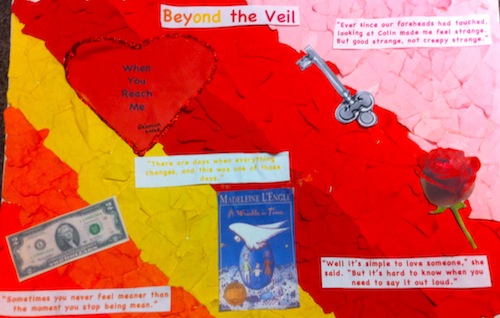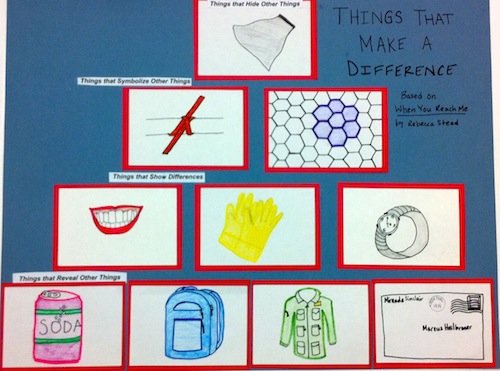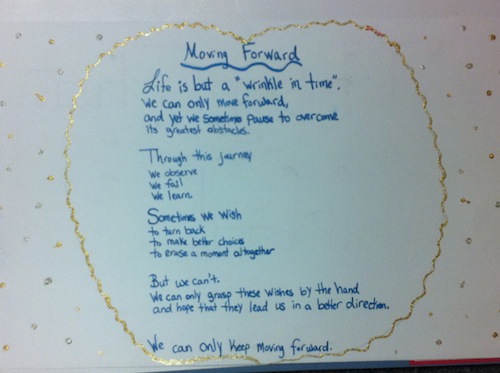By Andrea García, Hofstra University
–
Happy summer to the kids of New York City.
Read for joy.
Write for yourselves.
Rebecca Stead (http://rebeccastead.blogspot.com/ )
–
It is officially summer! As the school year comes to an end, and teachers pack up their classrooms, I have selected to focus my last blog entry for the month of June on sharing examples of a multimodal response project created by teachers to the 2010 Newberry award-winning book When You Reach Me by Rebecca Stead. This book was one of the choices I made available to teachers in my Children’s Literature course this past spring, and since it is a book that invites us to consider the possibility of time travel, why not use Stead’s work as inspiration as we imagine what we will do, what we will read, and what we will write this summer.
Critically acclaimed by readers everywhere, When You Reach Me tells the story of Miranda, a witty twelve year old girl living in New York City in 1978. We first meet Miranda as she is helping her single mother prepare to be a contestant in the television show The 20,000 Pyramid. Stead’s attention to detail in her narrative easily transports the reader into Miranda’s every day life, and into the issues that concern her as middle school girl, including friendships, family relationships and fears. Miranda’s life is suddenly filled with mystery, as she begins to receive notes from an unknown author who seems to know a lot about Miranda’s present and possible future life. Stead weaves together multiple storylines that move across time seamlessly, making this a captivating read. When you reach me is one of those books that keeps you thinking about the characters and about what their lives may look like in the future. In addition, there are multiple nuanced meanings in the story, which makes the book ideal to explore multiple personal interpretations to the story.
Similar to the multimodal response projects posted last week, teachers were asked to represent their personal interpretation to the story by using multiple sign systems. Their response should take into consideration how different sign systems may allow them to represent deeper personal meanings, while moving away from only print-based responses. While invited to use digital tools when composing their response, this was not a requirement for the project.
As we know, digital tools available to us as writers and readers are ideal for layering meaning using images, text, music, video, etc. Shannon took risks in crafting her response project to When You Reach Me and made use of an online presentation program called Prezi. WOW Currents readers may recall a previous discussion of digital tools that promote response to books in the 21st century (http://wowlit.org/blog/2010/11/29/responding-to-literature-in-the-21st-century-challenges-and-resources/#more-1070).
Shannon created a prezi, http://prezi.com/dzwjn23xa1re/four-notes/, in which she centered her response around the mysterious notes Miranda received in the story. Shannon used images to compose a personal interpretation of the story that brings to the forefront the intrigue and the sense of wonder experienced by Miranda, as well as by the reader. When presenting her work, Shannon explained that she entitled her presentation “Four Notes” and she then thought about what she would write about if it was something that she had been asked to do. Careful attention to design is evident in her composition, which reveals the decisions she made in terms of positioning text and juxtaposing her images. She also took advantage of the features provided by Prezi in her selection of movement and focus.
Amanda’s response was crafted in the form of a collage, where she used color, images and text. Amanda explained that her response focused on her need for representing the different emotions experienced by the characters using color. For example, she used orange for joy, yellow for trust, red for passion and pink for friendship. Amanda also layered her collage with images of items significant in the story that helped her represent how everything fell into place at the end of the story.
Using one of the subplots in the story, Mary composed her response making use of The 20,000 Pyramid as a metaphor for representing meaning and extending this to compose a poem. Using the title, Things that make a difference, Mary created a multimodal representation of things that were compelling for her as a reader, and that made her connect to the characters in the story. Under the subcategory of Things that show difference, Mary made reference to items that Miranda yearned for, representing Miranda’s awareness of difference in social and economic status between her and some of the other characters in the story.
Finally, Leah also made use of the metaphor of The 20,000 Pyramid in her visual representation of meaning, and then used Miranda’s favorite book in the story, A Wrinkle in Time by Madeleine D’Engle, as inspiration to write her own poem. Leah’s multilayered response represents her use of intertextual connections, which then influenced her writing.
As you prepare for your summer and make decisions about the books you will read and the writing that you will do, I hope that you will find inspiration in the responses composed by these teachers to think of what is possible to do with readers as they transact with high quality literature, and as they explore the potential of multiple modes of expression for representing their transactions with stories. What do you want to try next year with your students? How could multimodal response projects support your students as readers?
Journey through Worlds of Words during our open reading hours: Monday-Friday, 9 a.m. to 5 p.m. and Saturday, 9 a.m. to 1 p.m.
- Themes: Andrea García, Rebecca Stead, When You Reach Me
- Descriptors: Books & Resources, Student Connections, WOW Currents




